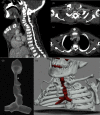Tracheal Resection for Critical Airway Obstruction in Morquio A Syndrome
- PMID: 37180285
- PMCID: PMC10171972
- DOI: 10.1155/2023/7976780
Tracheal Resection for Critical Airway Obstruction in Morquio A Syndrome
Abstract
Introduction: The primary cause of death in Morquio A syndrome (mucopolysaccharidosis (MPS) IVA) is airway obstruction, brought about by an inexorable and pathognomonic multilevel airway tortuosity, buckling, and obstruction. The relative pathophysiological contributions of an inherent cartilage processing defect versus a mismatch in longitudinal growth between the trachea and the thoracic cage are currently a subject of debate. Enzyme replacement therapy (ERT) and multidisciplinary management continue to improve life expectancy for Morquio A patients by slowing many of the multisystem pathological consequences of the disease but are not as effective at reversing established pathology. An urgent need has developed to consider alternatives to palliation of progressive tracheal obstruction to preserve and maintain these patients' hard-won good quality of life, as well as to facilitate spinal and other required surgery. Case Report. Following multidisciplinary discussion, transcervical tracheal resection with limited manubriectomy was successfully performed, without the need for cardiopulmonary bypass, in an adolescent male on ERT with the severe airway manifestations of Morquio A syndrome. His trachea was found to be under significant compressive forces at surgery. On histology, chondrocyte lacunae appeared enlarged, but intracellular lysosomal staining and extracellular glycosaminoglycan staining was comparable to control trachea. At 12 months, this has resulted in a significant improvement in respiratory and functional status, with corresponding enhancement to his quality of life.
Conclusion: This addressing of tracheal/thoracic cage dimension mismatch represents a novel surgical treatment approach to an existing clinical paradigm and may be useful for other carefully selected individuals with MPS IVA. Further work is needed to better understand the role and optimal timing of tracheal resection within this patient cohort so as to individually balance considerable surgical and anaesthetic risks against the potential symptomatic and life expectancy benefits.
Copyright © 2023 Claire Frauenfelder et al.
Conflict of interest statement
The authors declare that have no conflicts of interest.
Figures




References
Publication types
LinkOut - more resources
Full Text Sources

